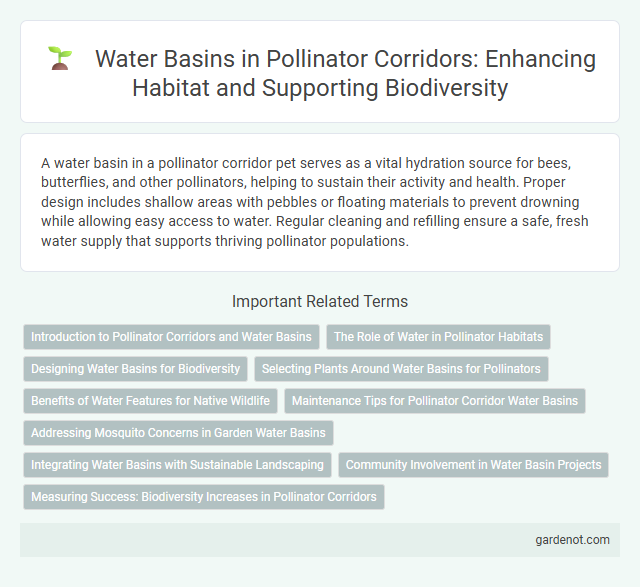A water basin in a pollinator corridor pet serves as a vital hydration source for bees, butterflies, and other pollinators, helping to sustain their activity and health. Proper design includes shallow areas with pebbles or floating materials to prevent drowning while allowing easy access to water. Regular cleaning and refilling ensure a safe, fresh water supply that supports thriving pollinator populations.
Introduction to Pollinator Corridors and Water Basins
Pollinator corridors are strategically designed landscapes that connect habitats, facilitating the movement of essential pollinators such as bees, butterflies, and hummingbirds. Water basins within these corridors act as vital ecological hubs, providing hydration sources and supporting diverse plant species that attract and sustain pollinator populations. Integrating water basins into pollinator corridors enhances habitat connectivity and promotes biodiversity resilience across fragmented ecosystems.
The Role of Water in Pollinator Habitats
Water basins serve as critical resources in pollinator corridors by providing hydration and supporting diverse floral growth essential for pollinator survival. The availability of clean water within these basins enhances the reproductive success of key pollinator species such as bees, butterflies, and hummingbirds. Maintaining natural water cycles and minimizing pollutants in water basins directly contribute to the health and biodiversity of pollinator habitats.
Designing Water Basins for Biodiversity
Designing water basins for biodiversity involves creating habitats that support diverse pollinator species by incorporating native flowering plants, shallow edges, and varied water depths. These features enhance nesting sites, provide continuous food sources, and improve habitat connectivity within pollinator corridors. Optimized water basins contribute to sustaining ecosystem services such as pollination, water purification, and flood mitigation.
Selecting Plants Around Water Basins for Pollinators
Selecting native, moisture-loving plants around water basins enhances pollinator corridors by providing essential nectar and pollen sources. Species such as milkweed, bee balm, and swamp milkweed attract diverse pollinators like bees, butterflies, and hummingbirds, supporting their life cycles. Strategically planting these species near water basins ensures a reliable habitat that sustains pollinators and promotes ecological balance.
Benefits of Water Features for Native Wildlife
Water basins within pollinator corridors create essential habitats that support native wildlife by providing consistent hydration and breeding grounds for various species. These water features enhance biodiversity by attracting pollinators such as bees, butterflies, and amphibians, fostering ecological balance. Incorporating water basins also aids in sustaining plant health and soil moisture, promoting a thriving environment for native flora and fauna.
Maintenance Tips for Pollinator Corridor Water Basins
Regularly inspect water basins in pollinator corridors to prevent algae buildup and stagnation, ensuring clean, fresh water for pollinators such as bees and butterflies. Incorporate native aquatic plants to maintain ecological balance and provide shelter while promoting natural filtration. Remove debris and monitor water levels frequently to sustain optimal hydration sources throughout varying seasons.
Addressing Mosquito Concerns in Garden Water Basins
Garden water basins designed as pollinator corridors require careful management to prevent mosquito breeding. Incorporating moving water features, such as small fountains or aerators, disrupts mosquito life cycles and reduces larvae development. Introducing natural predators like mosquito fish (Gambusia affinis) further controls mosquito populations while maintaining a healthy ecosystem for pollinators.
Integrating Water Basins with Sustainable Landscaping
Integrating water basins with sustainable landscaping enhances pollinator corridors by providing essential habitats and water sources for diverse pollinator species. Utilizing native plants around water basins supports ecological balance by promoting soil health and reducing runoff. Efficient water management in these basins aids in maintaining moisture levels critical for flowering plants that sustain pollinators throughout their lifecycle.
Community Involvement in Water Basin Projects
Community involvement in water basin projects significantly enhances the success of pollinator corridors by fostering local stewardship and sustainable water management practices. Engaging residents and stakeholders in water conservation efforts ensures the maintenance of natural habitats and the availability of clean water resources critical for pollinator health and biodiversity. Collaborative initiatives, such as citizen science monitoring and habitat restoration, empower communities to actively contribute to the protection and resilience of pollinator ecosystems within water basins.
Measuring Success: Biodiversity Increases in Pollinator Corridors
Biodiversity increases in pollinator corridors can be measured through systematic monitoring of water basins, which serve as critical habitats for diverse pollinator species. Water quality indicators, including nutrient levels and contamination rates, directly influence the health and diversity of flora and fauna within these basins. Enhanced pollinator activity and species richness correlate with improved aquatic ecosystem conditions, underscoring the success of targeted conservation efforts in pollinator corridors.
Water basin Infographic

 gardenot.com
gardenot.com